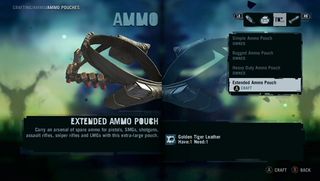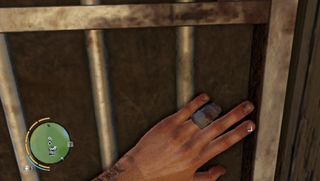Crafting is meaningful (or at least easier to understand)

Introduced with Assassin's Creed Revelations' bomb-crafting system, this is a relatively new trope for AC--but it's one that ACIII shares with Far Cry 3. In ACIII, crafting is accomplished by collecting craftspeople (who share a group story arc that unlocks crafting items) and recipes, eventually giving you a huge stock of items you can harvest and create. Some of these, like ammo pouches and weapons, have a clear gameplay use. The rest have no clear purpose other than to make money in the game's byzantine economy system, and making and selling them is complicated enough to befuddle all but the most patient players.
In Far Cry 3, meanwhile, skinning certain animals lets you make bigger ammo bags. That's pretty much it. We're not suggesting AC has to be so utilitarian and simple, but clearer item values, fun resource collection and more tangible rewards certainly wouldn't hurt.
For a tropical island, there aren't many bugs

It's funny how we as an audience have kind of just accepted that bugs are a necessary trade-off if we want to explore big, expansive open worlds filled with pretty things and cool stuff to do. And why not? When some of the biggest names in gaming roll out with glitches all up in everywhere, who are we to say they shouldn't? Never mind that the Assassins Creed series has generally been pretty clean; when ACIII rolled out with numerous bugs in tow (many of which have since been cleared up with a number of massive post-release patches), a lot of us shrugged and chalked it up to the pitfalls of open worlds and new tech.
Imagine our surprise, then, when we finished Far Cry 3 and realized that we'd barely seen any bugs at all. No sudden drops through seemingly solid terrain. No disappearing mission-critical enemies, no driverless jeeps, no sharks spawning on land--well, actually, some sharks spawning on land, but noticeable glitches were few and far between. Far Cry 3 was shockingly clean, raising the bar for what we should expect to see from free-roaming epics--and reminding us that Ubi Montreal has in fact cleared that bar many times before.
Its hero is fun and grows as a person

We get that, in creating Connor, the goal was to make a character wholly unlike Assassin's Creed's charismatic Ezio Auditore. But Connor may be an overcompensation. As a kid, he's earnest, good-natured and smart, showing the beginnings of a hugely likeable character. By the time he hits adulthood, however, he's become monotone, petulant and--dare we say it?--kinda boring.
Compare that to FC3's Jason Brody, who comes off as a spoiled, douchey rich kid at first, but nevertheless exhibits a strong moral center and a growing fearlessness. He's nave and earnest to a fault, but where Connor has the temperament of a warrior-monk, Brody is a blundering goof--and his flaws actually make him more interesting. He's not as suave or as competent as Ezio, but he's an entertaining guy to be around, and his attachment to his friends gives us something to cling to. He's a reminder that, in Connor's case, a little more personality could have done wonders.
WARNING--SPOILERS AHEAD

The final two entries deal with story, and contain some big spoilers for both Assassin's Creed III and Far Cry 3. If you've finished both games (or don't care about having them spoiled), read on--otherwise, you may want to stop here and come back later. You've been warned.
We can feel good about offing its villains

Compelling villains are a concept the AC series has wrestled with since ACII; with each successive game, its Templar baddies have grown less diabolical and more complex. In ACIII, we loved Haytham Kenway--but that's precisely the problem. He never really did anything terrible, making his inevitable defeat feel more tragic than triumphant. (Which was doubtless intentional, but still.)
FC3's villains, meanwhile, are fascinating to spend time with--but as riveting as they are, each is also an unambiguous psycho who regularly does despicable things. Vaas gives compelling monologues, but repeatedly tries to murder you. Buck is funny, but every conversation is tainted by the knowledge that he's almost certainly sexually assaulting one of Jason's friends off-camera. And Hoyt may be a fun guy to play cards against, but he's a terrifying slaver sociopath. We're a little sorry to see each one go, but--and this is important--we're never reluctant to stick the knife in.
You actually lose a finger

No Assassin's Creed protagonist has had to sacrifice one of their fingers since Altair, so this one wouldn't be significant at all if it weren't for one important detail: the finger that Jason Brody loses. The ring finger of the left hand is the Assassin finger, the one that Assassins traditionally cut off so as not to impede the Hidden Blade--until Leonardo Da Vinci improved the design. And even after Ezio skipped the step where he had to mutilate himself, the Assassins used the missing finger as an identifier--just like Lucy did, when she hid hers to send a signal to Desmond.
The fact that Jason loses that finger specifically near the end of the game makes us wonder: are Far Cry 3's designers just paying tribute to their co-workers at Ubisoft Montreal? Is it a nod to how many AC concepts they've incorporated into the game? Is it just a coincidence? Or does it hint at some eventual, gradual merging of the two franchises? Yeah, we're not holding our breath on that last one, either, but it's fun to consider.
Where to draw the line?

For all their similarities, there are plenty of hallmarks of Assassin's Creed that make the series unique, and Far Cry 3 hasn't even attempted to touch them. The free-running, the climbing, the historical recreations, the emphasis on close-quarters fighting, the Hidden Blades and hoods--all of these are vital, and for some, they're all the franchise really needs. Is lifting ideas from AC a step in the right direction for Far Cry? Is it something more games should do? Fewer? Let us know your thoughts in the comments below.
And if you're looking for more, check out our Far Cry 3 review and our Assassin's Creed III.

